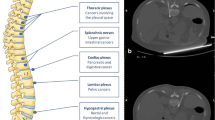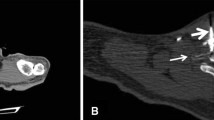Abstract
Purpose of Review
The purpose of this article is to describe the concepts of ablation techniques for pain relief in symptomatic oncologic patients. Controversies concerning techniques and products will be addressed.
Recent Findings
Despite conventional pain palliative techniques, cancer patients often endorse unresolved somatic and neuropathic pain that can present as a great burden to quality of life. In non-operative patients, several techniques have been applied to minimize opioid dependence. While radiotherapy is often considered as a non-invasive option, percutaneous ablation has been advanced as a minimally-invasive alternative with clear procedural and outcome advantages. Similar to radiation therapy, percutaneous ablation techniques can act either upon nerve structures responsible for pain mediation signals (neurolysis) or directly upon the tumor to relieve tumor-mediated inflammation and decompress tumor compression of adjacent structures.
Summary
Percutaneous ablation provides valuable neurolysis and tumor-directed pain palliative effects to be incorporated into clinical guidelines for pain reduction in oncologic patients. Selection among different ablation techniques should be based upon an individually tailored approach, to include consideration of all treatment modalities.

Similar content being viewed by others
References
Papers of particular interest, published recently, have been highlighted as: • Of importance
• Filippiadis DK, Tselikas L, Tsitskari M, Kelekis A, de Baere T, Ryan AG. Percutaneous Neurolysis for Pain Management in Oncological Patients. Cardiovasc Intervent Radiol. 2019;42(6):791–9. https://doi.org/10.1007/s00270-019-02185-x Recent multi-centered review providing details as well as tips and tricks for all kinds of percutaneous neurolysis techniques.
ESMO Guidelines working group. Bone health in cancer patients: ESMO clinical practice guidelines. Ann Oncol. 2014;25(Supplement 3):iii124–37. https://doi.org/10.1093/annonc/mdu103.
van den Beuken-van Everdingen MH, Hochstenbach LM, Joosten EA, Tjan-Heijnen VC, Janssen DJ. Update on prevalence of pain in patients with cancer: systematic review and meta-analysis. J Pain Symptom Manag. 2016;51(6):1070–1090.e9. https://doi.org/10.1016/j.jpainsymman.2015.12.340.
Mercadante S. Malignant bone pain: pathophysiology and treatment. Pain. 1997;69:1–18.
• Moynagh MR, Kurup AN, Callstrom MR. Thermal Ablation of Bone Metastases. Semin Interv Radiol. 2018;35(4):299–308. https://doi.org/10.1055/s-0038-1673422 Review providing details as well as tips and tricks for all kinds of percutaneous ablation techniques for osseous metastatic disease.
WHO. Cancer pain relief: with a guide to opioid availability. 2nd ed. 1996. http://apps.who. int/iris/bitstream/10665/37896/1/9241544821.pdf.
Martin BC, Fan MY, Edlund MJ, DeVries A, Braden JB, Sullivan MD. Long-term chronic opioid therapy discontinuation rates from the TROUP study. J Gen Intern Med. 2011;26:1450–7. https://doi.org/10.1007/s11606-011-1771-0.
Ballantyne JC, Kalso E, Stannard C. WHO analgesic ladder: a good concept gone astray. BMJ. 2016;6(352):i20. https://doi.org/10.1136/bmj.i20.
Vayne-Bossert P, Afsharimani B, Good P, Gray P, Hardy J. Interventional options for the management of refractory cancer pain--what is the evidence? Support Care Cancer. 2016;24(3):1429–38. https://doi.org/10.1007/s00520-015-3047-4.
Dennis K, Makhani L, Zeng L, Lam H, Chow E. Single fraction conventional external beam radiation therapy for bone metastases: a systematic review of randomised controlled trials. Radiother Oncol. 2013;106(1):5–14. https://doi.org/10.1016/j.radonc.2012.12.009.
Kelekis A, Cornelis FH, Tutton S, Filippiadis D. Metastatic osseous pain control: bone ablation and Cementoplasty. Semin Interv Radiol. 2017;34(4):328–36. https://doi.org/10.1055/s-0037-1608747.
Filippiadis D, Tutton S, Kelekis A. Pain management: the rising role of interventional oncology. Diagn Interv Imaging. 2017;98(9):627–34. https://doi.org/10.1016/j.diii.2017.06.015.
Tam A, Ahrar K. Palliative interventions for pain in Cancer patients. Semin Interv Radiol. 2007;24:419–29. https://doi.org/10.1055/s-2007-992330.
Cazzato RL, Garnon J, Ramamurthy N, Koch G, Tsoumakidou G, Caudrelier J, et al. Percutaneous image-guided cryoablation: current applications and results in the oncologic field. Med Oncol. 2016;33(12):140. https://doi.org/10.1007/s12032-016-0848-3.
Sidana A. Cancer immunotherapy using tumor cryoablation. Immunotherapy. 2014;6(1):85–93. https://doi.org/10.2217/imt.13.151.
Lubner MG, Brace CL, Hinshaw JL, Lee FT Jr. Microwave tumor ablation: mechanism of action, clinical results, and devices. J Vasc Interv Radiol. 2010;21(8 Suppl):S192–203. https://doi.org/10.1016/j.jvir.2010.04.007.
Napoli A, Anzidei M, Marincola BC, Brachetti G, Noce V, Boni F, et al. MR imaging-guided focused ultrasound for treatment of bone metastasis. Radiographics. 2018;38(2):603–23. https://doi.org/10.1148/rg.2018170129.
Mastier C, Gjorgjievska A, Thivolet A, Bouhamama A, Cuinet M, Pilleul F, et al. Musculoskeletal metastases management: the interventional Radiologist's toolbox. Semin Interv Radiol. 2018;35(4):281–9. https://doi.org/10.1055/s-0038-1673420.
Scheffer HJ, Nielsen K, de Jong MC, van Tilborg AAJM, Vieveen JM, Bouwman A(RA), et al. Irreversible electroporation for nonthermal tumor ablation in the clinical setting: a systematic review of safety and efficacy. J Vasc Interv Radiol. 2014;25(7):997–1011. https://doi.org/10.1016/j.jvir.2014.01.028.
Simon CJ, Dupuy DE, Mayo-Smith WW. Microwave ablation: principles and applications. Radiographics. 2005;25(Suppl 1):S69–83. https://doi.org/10.1148/rg.25si055501.
Drewes AM, Campbell CM, Ceyhan GO, Delhaye M, Garg PK, van Goor H, et al. Pain in pancreatic ductal adenocarcinoma: a multidisciplinary, international guideline for optimized management. Pancreatology. 2018;18(4):446–57. https://doi.org/10.1016/j.pan.2018.04.008.
Yarmohammadi H, Nakamoto DA, Azar N, Hayek SM, Haaga JR. Percutaneous computed tomography guided cryoablation of the celiac plexus as an alternative treatment for intractable pain caused by pancreatic cancer. J Cancer Res Ther. 2011;7(4):481–3. https://doi.org/10.4103/0973-1482.92024.
Golovac S. Radiofrequency neurolysis. Neuroimaging Clin N Am. 2010;20(2):203–14. https://doi.org/10.1016/j.nic.2010.02.007.
Kastler B, Michalakis D, Clair CH, Allal R, Delabrousse E, Peireira PH, et al. Stellate ganglion radiofrequency neurolysis under CT guidance. Preliminary study. JBR-BTR. 2001;84(5):191–4.
Amr SA, Reyad RM, Othman AH, Mohamad MF, Mostafa MM, Alieldin NH, et al. Comparison between radiofrequency ablation and chemical neurolysis of thoracic splanchnic nerves for the management of abdominal cancer pain randomized trial. Eur J Pain. 2018;2(10):1782–90. https://doi.org/10.1002/ejp.1274.
Bittman RW, Peters GL, Newsome JM, Friedberg EB, Mitchell JW, Knight JM, et al. Percutaneous image-guided Cryoneurolysis. AJR Am J Roentgenol. 2018;210(2):454–65. https://doi.org/10.2214/AJR.17.18452.
Kambadakone A, Thabet A, Gervais DA, Mueller PR, Arellano RS. CT-guided celiac plexus Neurolysis: a review of anatomy, indications, technique, and tips for successful treatment. RadioGraphics. 2011;31(6):1599–621. https://doi.org/10.1148/rg.316115526.
Nabil Abbas D, Abd el Ghafar EM, Ibrahim WA, Omran AF. Fluoroscopic stellate ganglion block for Postmastectomy pain: a comparison of the classic anterior approach and the oblique approach. Clin J Pain. 2011;27(3):207–13. https://doi.org/10.1097/AJP.0b013e3181fb1ef1.
Gangi A, Dietemann JL, Schultz A, Mortazavi R, Jeung MY, Roy C. Interventional radiologic procedures with CT guidance in cancer pain management. RadioGraphics. 1996;16(6):1289–304; discussion 1304-6. https://doi.org/10.1148/radiographics.16.6.8946536.
Narouze S. Ultrasound-guided stellate ganglion block: safety and efficacy. Curr Pain Headache Rep. 2014;18(6):424. https://doi.org/10.1007/s11916-014-0424-5.
Hol PK, Kvarstein G, Viken O, Smedby O, Tonnessen TI. MRI-guided celiac plexus block. J Magn Reson Imaging. 2000;12(4):562–4.
Wyse JM, Battat R, Sun S, Saftoiu A, Siddiqui AA, Leong AT, et al. Practice guidelines for endoscopic ultrasound-guided celiac plexus neurolysis. Endosc Ultrasound. 2017;6(6):369–75. https://doi.org/10.4103/eus.eus_97_17.
Haynsworth RF Jr, Noe CE. Percutaneous lumbar sympathectomy: a comparison of radiofrequency denervation versus phenol neurolysis. Anesthesiology. 1991;74(3):459–63.
Trescot AM. Cryoanalgesia in interventional pain management. Pain Physician. 2003;6(3):345–60.
Kawamata M, Ishitani K, Ishikawa K, Sasaki H, Ota K, Omote K, et al. Comparison between celiac plexus block and morphine treatment on quality of life in patients with pancreatic cancer pain. Pain. 1996;64(3):597–602.
Filippiadis DK, Tutton S, Mazioti A, Kelekis A. Percutaneous image-guided ablation of bone and soft tissue tumours: a review of available techniques and protective measures. Insights Imaging. 2014;5(3):339–46. https://doi.org/10.1007/s13244-014-0332-6.
Kurup AN, Callstrom MR. Image-guided percutaneous ablation of bone and soft tissue tumors. Semin Interv Radiol. 2010;27(3):276–84. https://doi.org/10.1055/s-0030-1261786.
Gangi A, Buy X. Percutaneous bone tumor management. Semin Interv Radiol. 2010;27(2):124–36. https://doi.org/10.1055/s-0030-1253511.
Rosenthal D, Callstrom MR. Critical review and state of the art in interventional oncology: benign and metastatic disease involving bone. Radiology. 2012;262(3):765–80. https://doi.org/10.1148/radiol.11101384.
Gangi A, Tsoumakidou G, Buy X, Quoix E. Quality improvement guidelines for bone tumour management. Cardiovasc Intervent Radiol. 2010;33(4):706–13. https://doi.org/10.1007/s00270-009-9738-9.
• Kurup AN, Schmit GD, Morris JM, Atwell TD, Schmitz JJ, Weisbrod AJ, et al. Avoiding complications in bone and soft tissue ablation. Cardiovasc Intervent Radiol. 2017;40(2):166–76. https://doi.org/10.1007/s00270-016-1487-y Recent review providing details as well as tips and tricks for avoiding complications during bone ablation.
Tsoumakidou G, Garnon J, Ramamurthy N, Buy X, Gangi A. Interest of electrostimulation of peripheral motor nerves during percutaneous thermal ablation. Cardiovasc Intervent Radiol. 2013;36(6):1624–8. https://doi.org/10.1007/s00270-013-0641-z.
Vaswani D, Wallace AN, Eiswirth PS, Madaelil TP, Chang RO, Tomasian A, et al. Radiographic local tumor control and pain palliation of sarcoma metastases within the musculoskeletal system with percutaneous thermal ablation. Cardiovasc Intervent Radiol. 2018;41(8):1223–32. https://doi.org/10.1007/s00270-018-1932.
Ma Y, Wallace AN, Waqar SN, Morgensztern D, Madaelil TP, Tomasian A, et al. Percutaneous image-guided ablation in the treatment of osseous metastases from non-small cell lung Cancer. Cardiovasc Intervent Radiol. 2018;41(5):726–33. https://doi.org/10.1007/s00270-017-1843-6.
Deib G, Deldar B, Hui F, Barr JS, Khan MA. Percutaneous microwave ablation and Cementoplasty: clinical utility in the treatment of painful Extraspinal osseous metastatic disease and myeloma. AJR Am J Roentgenol. 2019;212:1–8. https://doi.org/10.2214/AJR.18.20386.
Pusceddu C, Sotgia B, Fele RM, Ballicu N, Melis L. Combined microwave ablation and Cementoplasty in patients with painful bone metastases at high risk of fracture. Cardiovasc Intervent Radiol. 2016;39(1):74–80. https://doi.org/10.1007/s00270-015-1151-y.
Coupal TM, Pennycooke K, Mallinson PI, Ouellette HA, Clarkson PW, Hawley P, et al. The hopeless case? Palliative Cryoablation and Cementoplasty procedures for palliation of large pelvic bone metastases. Pain Physician. 2017;20(7):E1053–61.
Gallusser N, Goetti P, Becce F, Vauclair F, Rüdiger HA, Bize PE, et al. Percutaneous image-guided cryoablation of painful bone metastases: a single institution experience. Orthop Traumatol Surg Res. 2019;105(2):369–74. https://doi.org/10.1016/j.otsr.2019.01.001.
Cazzato RL, Garnon J, Caudrelier J, Rao PP, Koch G, Gangi A. Low-power bipolar radiofrequency ablation and vertebral augmentation for the palliative treatment of spinal malignancies. Int J Hyperth. 2018;34(8):1282–8. https://doi.org/10.1080/02656736.2017.1422557.
Goetz MP, Callstrom MR, Charboneau JW, Farrell MA, Maus TP, Welch TJ, et al. Percutaneous image-guided radiofrequency ablation of painful metastases involving bone: a multicenter study. J Clin Oncol. 2004;22(02):300–6. https://doi.org/10.1200/JCO.2004.03.097.
Callstrom MR, Dupuy DE, Solomon SB, Beres RA, Littrup PJ, Davis KW, et al. Percutaneous image guided cryoablation of painful metastases involving bone: multicenter trial. Cancer. 2013;119(05):1033–104. https://doi.org/10.1002/cncr.27793.
Dupuy DE, Liu D, Hartfeil D, Hanna L, Blume JD, Ahrar K, et al. Percutaneous radiofrequency ablation of painful osseous metastases: a multicenter American College of Radiology Imaging Network trial. Cancer. 2010;116(04):989–97. https://doi.org/10.1002/cncr.24837.
Bagla S, Sayed D, Smirniotopoulos J, Brower J, Neal Rutledge J, Dick B, et al. Multicenter prospective clinical series evaluating radiofrequency ablation in the treatment of painful spine metastases. Cardiovasc Intervent Radiol. 2016;39(09):1289–97. https://doi.org/10.1007/s00270-016-1400-8.
Gennaro N, Sconfienza LM, Ambrogi F, Boveri S, Lanza E. Thermal ablation to relieve pain from metastatic bone disease: a systematic review. Skelet Radiol. 2019;48(8):1161–9. https://doi.org/10.1007/s00256-018-3140-0.
Zugaro L, DI Staso M, Gravina GL, et al. Treatment of osteolytic solitary painful osseous metastases with radiofrequency ablation or cryoablation: a retrospective study by propensity analysis. Oncol Lett. 2016;11(03):1948–54. https://doi.org/10.3892/ol.2016.4108.
Greenwood TJ, Wallace A, Friedman MV, Hillen TJ, Robinson CG, Jennings JW. Combined ablation and radiation therapy of spinal metastases: a novel multimodality treatment approach. Pain Physician. 2015;18(6):573–81.
Kam NM, Maingard J, Kok HK, Ranatunga D, Brooks D, Torreggiani WC, et al. Combined vertebral augmentation and radiofrequency ablation in the Management of Spinal Metastases: an update. Curr Treat Options in Oncol. 2017;18(12):74. https://doi.org/10.1007/s11864-017-0516-7.
• Di Staso M, Zugaro L, Gravina GL, Bonfili P, Marampon F, Di Nicola L, et al. A feasibility study of percutaneous Radiofrequency Ablation followed by Radiotherapy in the management of painful osteolytic bone metastases. Eur Radiol. 2011;21(9):2004–10. https://doi.org/10.1007/s00330-011-2133-3 Feasibility study reporting significantly better results concerning pain reduction when combined approaches (Radiotherapy and ablation) are applied.
Di Staso M, Gravina GL, Zugaro L, Bonfili P, Gregori L, Franzese P, et al. Treatment of solitary painful osseous metastases with radiotherapy, Cryoablation or combined therapy: propensity matching analysis in 175 patients. PLoS One. 2015;10(6):e0129021. https://doi.org/10.1371/journal.pone.0129021.
Author information
Authors and Affiliations
Corresponding author
Ethics declarations
Conflict of Interest
Dimitrios K. Filippiadis declares that he has no conflict of interest.
Steven Yevich declares that he has no conflict of interest.
Frederic Deschamps declares that he has no conflict of interest.
Jack W. Jennings has received compensation from Merit Pharmaceuticals, Medtronic, and BTG plc for service as a consultant.
Sean Tutton declares that he has no conflict of interest.
Alexis Kelekis declares that he has no conflict of interest.
Human and Animal Rights and Informed Consent
This article does not contain any studies with human or animal subjects performed by any of the authors.
Additional information
Publisher’s Note
Springer Nature remains neutral with regard to jurisdictional claims in published maps and institutional affiliations.
This article is part of the Topical Collection on Palliative Medicine
Rights and permissions
About this article
Cite this article
Filippiadis, D.K., Yevich, S., Deschamps, F. et al. The Role of Ablation in Cancer Pain Relief. Curr Oncol Rep 21, 105 (2019). https://doi.org/10.1007/s11912-019-0844-9
Published:
DOI: https://doi.org/10.1007/s11912-019-0844-9




